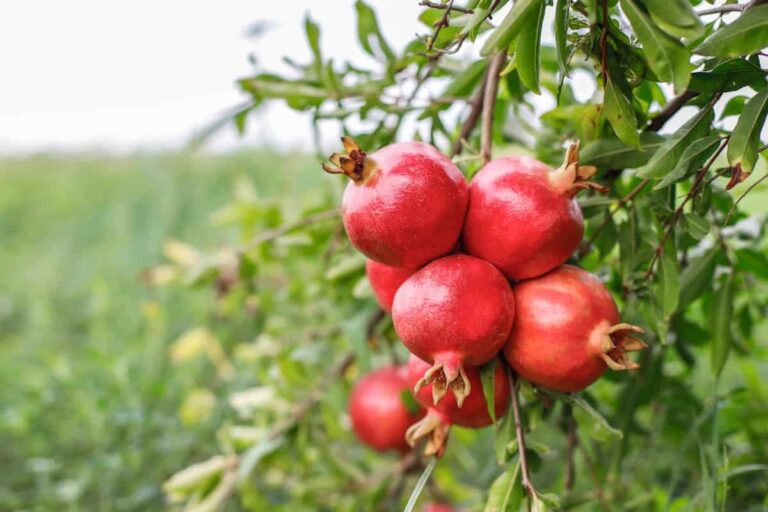Welcome to the enchanting world of the Pomegranate Tree (Punica granatum)! Known for its captivating beauty and delicious, jewel-like fruits, this ancient botanical wonder has a story that stretches back through the annals of time.
Originating from the region spanning from Iran to northern India, this iconic tree boasts glossy green leaves and vibrant, crimson flowers that eventually transform into luscious, ruby-red pomegranates. While its elegance may seem daunting, fear not! With moderate care, the Pomegranate Tree rewards gardeners with abundant fruit and a mesmerizing addition to any landscape.
Common Varieties:
- Sweet Pomegranate
- Desertnyi Pomegranates
- Pink Satin Pomegranate
- Ambrosia Pomegranate
- Parfianka Pomegranate
- Sharp Velvet Pomegranate
Care
Pomegranate Trees are pretty tolerant ones, so you won’t have too much trouble keeping them happy. Here are the key things to keep in mind:
- Soil: Pomegranate trees prefer well-drained soil, adapting to various types from acid loam to alkaline soils.
- Water: While they are drought-tolerant, regular deep watering is essential during the dry season to ensure proper fruit production. However, be cautious not to overwater, as it may lead to a poor harvest and increase susceptibility to pests and diseases.
- Light: Pomegranate shrubs thrive in sunny and warm locations, requiring at least six hours of full sun per day for a bountiful harvest.
- Temperature: They prefer cool winters and hot, dry summers. They can withstand temperatures as low as 10 degrees Fahrenheit, but in extreme cold, growing them in containers and sheltering them indoors is recommended to avoid frost damage.
Propagation
The most common ways of propagating these beautiful trees are through cuttings and seeds. Propagation by cuttings involves taking a healthy branch and rooting it in a suitable growing medium. Growing from seeds is also possible, but it may result in some variability in the fruit characteristics.
Pruning
Pomegranate trees tend to produce suckers, so it’s best to remove them as they pop up. If you choose not to prune, your tree will grow into a wider, bushier form. However, regular pruning, especially in the early years, encourages healthy new shoots and a better harvest. Once established, focus on pruning away dead or damaged branches (just like you do with the Butterfly Bush), and thin out fruits on the branches to help them grow to their full size and prevent limb breakage due to excessive weight.
Common Pests
Frequently Asked Questions
To take care of a pomegranate tree, plant it in a sunny and warm spot, providing at least six hours of sunlight daily. Use well-drained soil, water deeply during the dry season without overwatering, and remove suckers. Regular pruning, especially in the early years, encourages healthy growth and a bountiful harvest. Once established, focus on removing dead or damaged branches and thinning out fruits to promote their full growth and prevent limb breakage.
Do pomegranate trees lose their leaves in winter?
Yes, the tree loses its leaves in the fall – early winter. They regrow in the next spring.
Where do pomegranate trees grow best?
The optimal growing areas for this fruit are USDA Plant Hardiness Zones 7 to 10. T
How long does it take for a pomegranate to fruit?
The time it takes for a pomegranate tree to produce fruit can vary depending on several factors, including the tree’s age, variety, growing conditions, and care. In general, most pomegranate trees will start to bear fruit within 2 to 4 years after being planted. However, some varieties may take a bit longer, possibly up to 5 years, to produce their first fruits.
Do pomegranates grow well in pots?
Some versions – like the Sweet Pomegranate Tree – feel pretty good in a large container.


